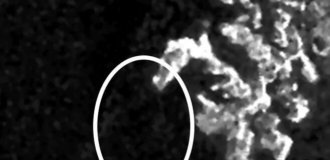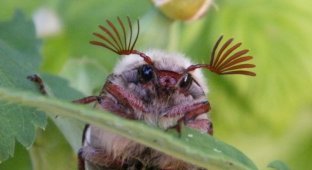Another miracle of nature, the dung beetle (11 photos + 1 video)
Many people confuse bronze beetles with dung beetles, although they are completely different beetles. So let's do a little educational program. Today we’ll talk about dung beetles, and specifically about the common dung beetle.

A little biology
A rather large beetle, from 16 to 27 mm long, shiny, the upper side is black-blue, black-green or black with a blue or green border, the underside is purple, blue, rarely greenish-blue. The entire abdomen has uniform points and hairs. Adult beetles are found from April to November. This representative of the lamellate belongs to the subfamily of earthmovers (Geotmpinae). Beetles and larvae of shrews feed on the droppings of vertebrate animals.

The common dung beetle is a shiny, slow-moving, bulbous-backed beetle that lives in pastures, meadows and woodlands. The coloring of this beetle is inconspicuous. Dung beetles are found in large numbers in areas where large mammals live.
The dung beetle's food of choice is horse droppings, although its diet also includes roe deer and deer excrement.

The body shape of all species of dung beetles is round or oval. The length, depending on the type, ranges from 3 to 70 mm. The coloring of the hard shell is very diverse. The underside of the hard belly is most often purple or blue.
The top has all sorts of shades of yellow, brown, black with a metallic sheen effect. The antennae resemble 11-segment antennas, which at the tips are twisted in the shape of a pinhead, also with three segments. All segments have pubescence.

The common dung beetle is often also called the horse dung beetle, since it is horse dung that is the most delicious food for it. Although in the absence of this “delicacy” he is quite content with cattle manure. In search of dung heaps, beetles usually fly in the evening, in calm weather. Their flight is difficult, accompanied by a loud hum. The people even have a riddle-proverb related to this: “When it flies, it howls, but when it lands, it digs the ground.” Having encountered any obstacle in flight, the beetle noisily falls to the ground.

Dung beetles find droppings and, burrowing to a depth of 50 cm to 2-3 m, prepare a kind of “nest” for the future larva: they prepare a ball of dung, into which the female lays an egg. Thus, the larvae are provided with food until they pupate completely. Other types of dung beetles lay eggs directly in the droppings, which will become not only food for the larvae, but also a home. After 28 days, dung beetle larvae emerge from the laid eggs.

Dung beetle larvae feed on manure until winter arrives. In the spring of next year, an adult insect emerges from the pupa.

Interesting Facts
- These little hard workers are very strong and resilient. They are capable of rolling dung balls several times their volume and 2-3 times heavier than their own weight.
- During fog they can extract moisture. Having spread their wings, the beetles remain motionless and moisture particles collect in a drop of water on the beetle's head. From there it flows straight into his mouth.
- Some species of dung beetles live in small colonies, building burrows underground, living there for generations

- Not everyone knows that the dung beetle, forming a ball of dung and transporting it to its destination, is guided by the stars.
- Dung beetles can predict the weather. The abundance of these flying insects indicates calm and clear weather the next day.
- During the entire period of their growth, dung beetle larvae feed on carefully prepared manure and do not defecate, so as not to be poisoned by their own waste. Everything “accumulates” in a special bag, which gradually forms a hump in the larva.
- Adult dung beetles can feed not only on droppings from various animals, but also on carrion.
[media=https://www.youtube.com/watch?v=xgAcNPrshng]
- Adult beetles live for about 2 months, during which time they manage to produce numerous offspring.
- Beetles are of particular importance, which was confirmed after the importation of ungulates to Australia - the lack of orderlies affected the deterioration of the state of nature, so dung beetles and shrews were then introduced.
- Beetles often become prey for foxes, which usually come to places where insects are crowded. Parasitic mites and helminths cause harm to the health of beetles.
- The beetle can sense danger; in alarming situations it begins to creak.

- Australian dung beetles can only feed on the droppings of endemic animals that have long inhabited the continent. To eliminate livestock manure that was brought to Australia, they began to breed the African dung beetle, which specializes in such food.
- It is worth noting that dung beetles can carry out their work with their front and hind legs - that’s how skilled they are.
- The common dung beetle is a relative of the scarab, the sacred beetle of Ancient Egypt, the image of which is found on ancient jewelry and religious objects.

- There are more than 600 species of dung beetles.
- Along with manure, the dung beetle also distributes plant seeds. This is a very important factor for the entire ecosystem. The dung beetle helps restore forests where trees were cut down by humans or plants were killed by fire.
- Hans Anderson's fairy tale "The Dung Beetle"
- The famous entomologist Jean Henri Fabre once conducted an experiment. He pinned the ball to the ground with a long needle. The beetle suffered for a long time, trying to move the ball from its place, then he made a dig, found a needle and tried to lift the ball, using his back as a lever. The beetle did not think of dragging the pebble lying nearby and standing on it, but as soon as the scientist placed the pebble, the scarab immediately used it and removed the ball from the pin.























